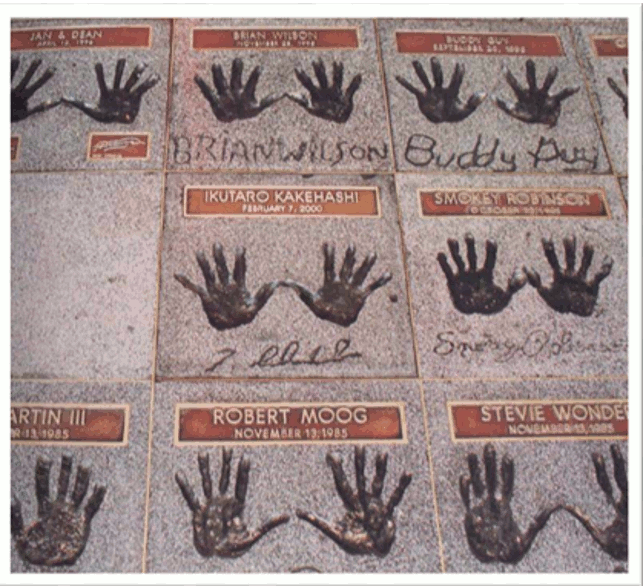After seeing Autodesk’s Ember 3D printer in action and discussing the company’s Spark platform plans, Al Dean has a chance conversation about MIDI that makes him realise Autodesk might be onto something

Ikutaro Kakehashi’s handprints on the Rock Walk Hall of Fame in Hollywood, sandwiched between Bob Moog and Brian Wilson. It doesn’t get much better than that
A big part of my job as editor of this fine publication isn’t necessarily writing or editing the magazine.
Much of my time is spent meeting folks out there who are doing interesting things. Then connecting them up with other people who can assist, who should work together and who need help.
Whether that’s introducing someone with a product idea to an industrial design team, or two vendors working in similar fields that should be co-operating rather than competing to little benefit. It’s this that’s the really fun part of the job.
Attending an event like Autodesk University, which takes place in Las Vegas at the beginning of each December, usually means a lot of catching up with folks I’ve not seen in a while, making some new contacts and learning about what the company is up to. Perhaps the biggest news out of Autodesk of late is the forthcoming launch of its Ember 3D printer.
Based on stereolithography (SLA) technology, it’s the hardware part of a much bigger play in the field. While Ember is the 3D print output, the Spark platform is where the interest really is.
The company has spent time looking at the market, finding where the weak points are and is looking to address these with a combination of both its own knowledge and through acquisitions (it acquired WithinLab earlier last year).
Autodesk is signing up partners at a pretty rapid rate. From smaller players looking for help with development of software, through community players like 3DHubs and into the emerging higher end of the spectrum, having already signed up HP as a partner.
Drawing an analogy with MIDI in the music industry
When I got back to the UK I had a few connections and introductions to make between folks that I met at the event and those that we’ve known for a while.
One such connection was with the folks at Roland. DEVELOP3D readers will be more than familiar with its products, what it does and how successful it has been — predominantly in Europe and Japan (strangely, it is relatively unknown for its desktop mills and 3D scanners in North America).
It was during an email that followed that introduction that Peter Kettle, Roland’s main man in the UK, brought up the subject of MIDI.
Roland was founded by Ikutaru Kakehashi (he’d already formed and left what became Hammond Organ) in early 1970s. Frustrated by the lack of interoperability between the products of the nascent musical synthesiser market, Kakehashi worked with Dave Smith and invented the MIDI (Musical Instrument Digital Interface) format.
For those that aren’t familiar with it, this is the standardised language that is used to communicate between almost every piece of electronic musical equipment on the planet.
It’s standard, it’s widespread, Wikipedia describes it best, stating: “MIDI carries event messages that specify notation, pitch and velocity, control signals for parameters such as volume, vibrato, audio panning, cues, and clock signals that set and synchronise tempo between multiple devices. These messages are sent to other devices where they control sound generation and other features.”
What’s interesting from this brief description is that you can draw analogies between the synthesiser market and the 3D printer industry. At the moment, we have a range of machines, of varying complexity, with specific requirements and workflows, but which have the same basic inputs — geometry, build material and any supports required, machine parameters and such.
As we move into an era where multiple materials and more complex geometry can be defined, then the issue of compatibility between generating systems (3D CAD) and the output tools (the printers) will become more prevalent.
Just as Kakehashi and Smith saw an opportunity to increase the productivity of its customers and grow the market as a whole through allowing the machines to talk to each other, it would seem that Autodesk is looking to do the same.
Can Autodesk succeed?
This is the big question. Standards rise to prominence because user adoption and industry adoption work in tandem.
Whether it’s the VHS format gaining dominance over some of the more questionable aspects of the movie entertainment industry who took its side over betamax. Some vendors fight back, but eventually, given the correct conditions, they have to come around in the end.
STL and, its newer cousin, AMF aren’t cutting it and it’s becoming apparent that, as technologies advance, we need something more advanced and sophisticated than pure triangle meshes and a bit of meta data here and there.
Autodesk has, in its community of users, a vast array of industries, of user levels (consider its consumer applications for both the desktop and the mobile device market) and it has cash. In fact, the company just announced a $100 million fund to seed 3D print initiatives.
It has its own 3D printer on the way, in the form of the Ember. It also has a finishing and post curing device on the way — something that the industry, particularly since the rebirth of interest in the SLA/UV curable market, has been crying out for.
It’s also building up a platform that will allow many of these systems and services to communicate with one another more efficiently.
Sound familiar?
Could Autodesk be onto something with its move into 3D printing technology?
Default






